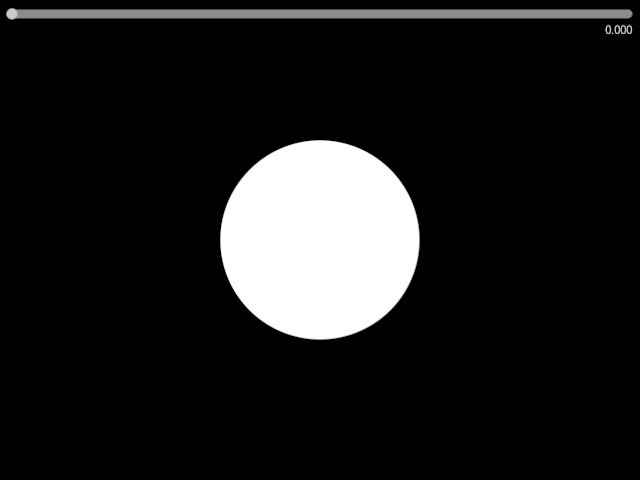Create animated timelines by specifying properties and times in keyframes, then play it back at any speed (even backwards) automatically interpolating properties. Save, load, use mathematical expressions and callbacks. Powerful and highly reusable.
What this allows you to do:
- Create a keyframed animation in a json file.
[
{
"time": 0.0,
"easing": "cubic-in-out",
"x": 3.0,
"y": 4.0,
"z": 9.0,
"r": 0.1,
"g": 0.5,
"b": 0.2,
"radius": 50
},
{
"time": 2.0,
"easing": "cubic-in-out",
"r": 0.6,
"g": 0.5,
"b": 0.1
},
{
"time": 4.0,
"easing": "cubic-in-out",
"x": 10.0,
"y": 4.0,
"radius": 400
},
{
"time": 5.0,
"easing": "cubic-in-out",
"x": 100.0,
"y": 320.0,
"radius": 400
},
{
"time": 5.3,
"easing": "cubic-in-out",
"x": 100.0,
"y": 320.0,
"radius": {
"value": 50.0,
"easing": "linear"
}
}
]- Map the animation data to Kotlin types:
class Animation : Keyframer() {
val position by Vector2Channel(arrayOf("x", "y"))
val radius by DoubleChannel("radius")
val color by RGBChannel(arrayOf("r", "g", "b"))
}
val animation = Animation()
animation.loadFromJson(File("data/keyframes/animation.json"))- Animate! (from an OPENRNDR program)
extend {
animation(seconds)
drawer.fill = animation.color
drawer.circle(animation.position, animation.radius)
}All the easing functions of orx-easing are available
- linear
- back-in
- back-out
- back-in-out
- bounce-in
- bounce-out
- bounce-in-out
- circ-in
- circ-out
- circ-in-out
- cubic-in
- cubic-out
- cubic-in-out
- elastic-in
- elastic-out
- elastic-in-out
- expo-in
- expo-out
- expo-in-out
- quad-in
- quad-out
- quad-in-out
- quart-in
- quart-out
- quart-in-out
- quint-in
- quint-out
- quint-in-out
- sine-in
- sine-out
- sine-in-out
- one
- zero
orx-keyframer has two ways of programming key frames. The first is the "x": <number> style we have seen before. The
second way uses a dictionary instead of a number value.
For example:
[
{
"time": 0.0,
"x": 320.0,
"y": 240.0
},
{
"time": 10.0,
"easing": "cubic-out",
"x": {
"easing": "cubic-in-out",
"value": 0.0
},
"y": {
"duration": -5.0,
"easing": "cubic-in",
"value": 0.0
}
},
{
"time": 20.0,
"x": 640.0,
"y": 480.0,
"easing": "cubic-in-out"
}
]Inside the value dictionary one can set value, easing, duration and envelope.
valuethe target value, required valueeasingeasing method that overrides the key's easing method, optional valuedurationan optional duration for the animation, set to0to jump from the previous value to the new value, a negative value will start the interpolation beforetime. A positive value wil start the interpolation attimeand end attime + durationenvelopeoptional 2-point envelope that modifies the playback of the animation. The default envelope is[0.0, 1.0]. Reverse playback is achieved by supplying[1.0, 0.0]. To start the animation later try[0.1, 1.0], to end the animation earlier try[0.0, 0.9]
orx-keyframer uses two file formats. A SIMPLE format and a FULL format. For reference check
the example full format .json and
the example program. The full format adds a parameters block and a prototypes
block.
Expressions, expression mechanism. Currently uses values r to
indicate repeat index and t the last used key time, v the last used value (for the animated attribute).
Supported functions in expressions:
min(x, y),max(x, y)cos(x),sin(x),acos(x),asin(x),tan(x),atan(x),atan2(y, x)abs(x),saturate(x)degrees(x),radians(x)pow(x, y),sqrt(x),exp(x)mix(left, right, x)smoothstep(t0, t1, x)map(leftBefore, rightBefore, leftAfter, rightAfter, x)random(),random(min, max)





